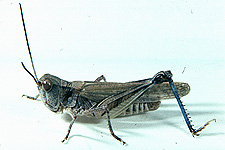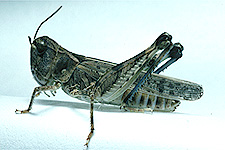Grasshoppers of Wyoming and the West
Entomology
Aulocara elliotti (Thomas)
 |
 |
| Adult male | Adult female |
Common name - Big-headed grasshopper (Pfadt, 1949a) or the Elliott grasshopper (Ball et al., 1942).
Geographic distribution - British Columbia to Manitoba (Canada), south to Mexico (Brooks, 1958; Otte, 1981). In Colorado it is found mainly in the eastern portion of the state from the foothills to the Kansas border but also may be found in the western part of the state (Pfadt, 1 949a).
Colorado Distribution Map - Aulocara elliotti
Habitat - lives in open, dry grasslands, mostly on the short grass plains where soil is coarse (Hantsbarger, 1979; Pfadt, 1949a).
Food habits - eats many different grasses but prefers bluegrass, blue grama, needleandthread, beardgrass, cheatgrass brome and western wheatgrass (Brooks, 1958; Hewitt, 1977; Mulkern et al., 1969; Pfadt, 1949a).
Eggs - pods are small, tough and truncate at one end and contain three to 11 pearly white eggs. Average egg length, 5 mm; average diameter, 1 mm (Ferkovich, 1965; Hastings and Pepper, 1964; Roemhild, 1967; Shotwell, 1941).
Nymph - five instars (Scoggan and Brusven, 1972).
Adult - small to medium size. General color is dull, reddish-brown. Face is slightly slanted back. Vertex is rounded. Head appears large in relation to body. Dorsal posterior margin of pronotum is rounded. Pronotum has two diagonal light stripes forming an "X" dorsally. Tegmina are opaque tan with brown spots. Wings are clear. Hind tibiae are blue. Male length, 20 mm; female, 30 mm (Ball et al., 1942; Hantsbarger, 1979).
Oviposition - after mating there is a preovipositional period of two weeks. Then the females lay their eggs in the upper 1/4 in. crust of undisturbed, open, packed ground or in bare spots of grainfields, native grasslands or hayfields. Egg pods usually are attached to solid objects such as roots or small stones. Egg deposition continues until early autumn (Anderson and Hastings, 1966; Ferkovich, 1965; Shotwell, 1941).
Seasonal history - overwinters in the egg stage. In Colorado adults appear from mid-June to August, 30 to 50 days after hatching. They feed until the first heavy frost (Ferkovich, 1965).
Abundance and importance - common on the grasslands. Damaging outbreaks occasionally occur (Hantsbarger, 1979; Pfadt, 1949a).
A. elliotti fact sheet from the Field Guide to Common Western Grasshoppers
Next Species: Aulocara femoratum
Previous Species: Arphia pseudonietana
Biology of Common Colorado Grasshoppers List
Biology of Common Colorado Grasshoppers
Grasshoppers of Colorado Contents

